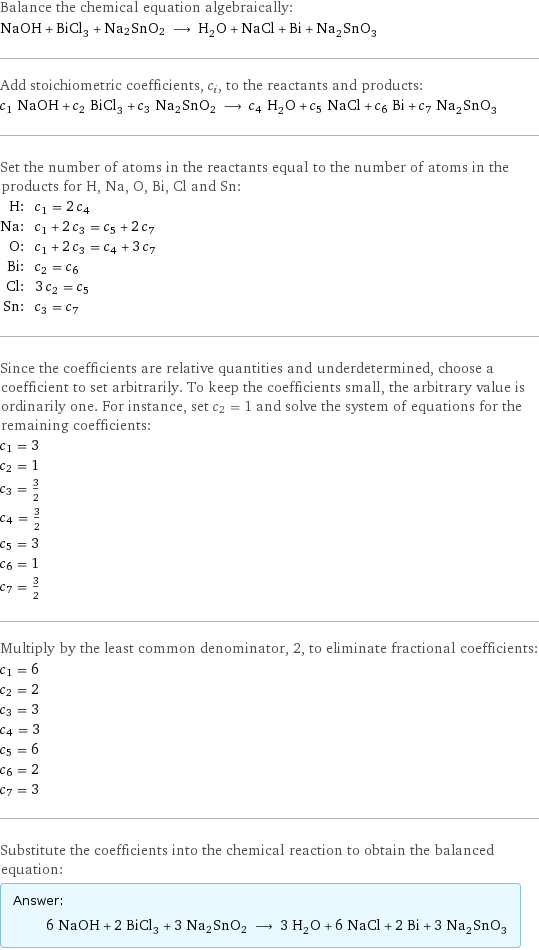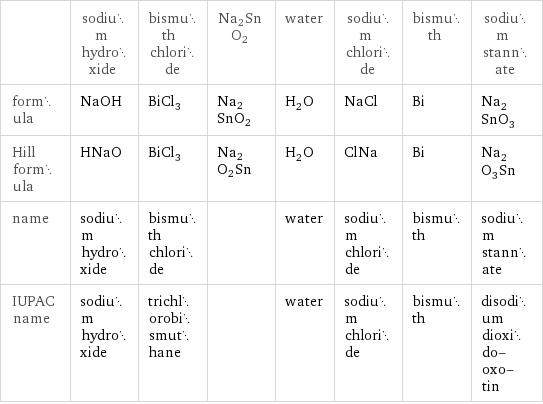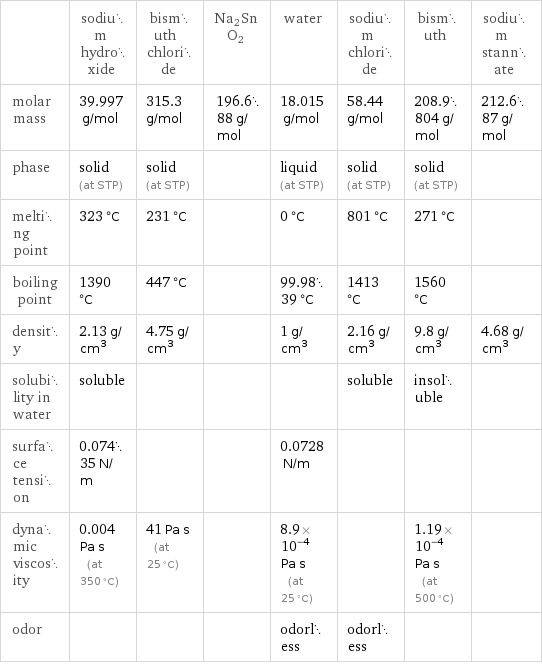Input interpretation

NaOH sodium hydroxide + BiCl_3 bismuth chloride + Na2SnO2 ⟶ H_2O water + NaCl sodium chloride + Bi bismuth + Na_2SnO_3 sodium stannate
Balanced equation

Balance the chemical equation algebraically: NaOH + BiCl_3 + Na2SnO2 ⟶ H_2O + NaCl + Bi + Na_2SnO_3 Add stoichiometric coefficients, c_i, to the reactants and products: c_1 NaOH + c_2 BiCl_3 + c_3 Na2SnO2 ⟶ c_4 H_2O + c_5 NaCl + c_6 Bi + c_7 Na_2SnO_3 Set the number of atoms in the reactants equal to the number of atoms in the products for H, Na, O, Bi, Cl and Sn: H: | c_1 = 2 c_4 Na: | c_1 + 2 c_3 = c_5 + 2 c_7 O: | c_1 + 2 c_3 = c_4 + 3 c_7 Bi: | c_2 = c_6 Cl: | 3 c_2 = c_5 Sn: | c_3 = c_7 Since the coefficients are relative quantities and underdetermined, choose a coefficient to set arbitrarily. To keep the coefficients small, the arbitrary value is ordinarily one. For instance, set c_2 = 1 and solve the system of equations for the remaining coefficients: c_1 = 3 c_2 = 1 c_3 = 3/2 c_4 = 3/2 c_5 = 3 c_6 = 1 c_7 = 3/2 Multiply by the least common denominator, 2, to eliminate fractional coefficients: c_1 = 6 c_2 = 2 c_3 = 3 c_4 = 3 c_5 = 6 c_6 = 2 c_7 = 3 Substitute the coefficients into the chemical reaction to obtain the balanced equation: Answer: | | 6 NaOH + 2 BiCl_3 + 3 Na2SnO2 ⟶ 3 H_2O + 6 NaCl + 2 Bi + 3 Na_2SnO_3
Structures

+ + Na2SnO2 ⟶ + + +
Names

sodium hydroxide + bismuth chloride + Na2SnO2 ⟶ water + sodium chloride + bismuth + sodium stannate
Equilibrium constant
![Construct the equilibrium constant, K, expression for: NaOH + BiCl_3 + Na2SnO2 ⟶ H_2O + NaCl + Bi + Na_2SnO_3 Plan: • Balance the chemical equation. • Determine the stoichiometric numbers. • Assemble the activity expression for each chemical species. • Use the activity expressions to build the equilibrium constant expression. Write the balanced chemical equation: 6 NaOH + 2 BiCl_3 + 3 Na2SnO2 ⟶ 3 H_2O + 6 NaCl + 2 Bi + 3 Na_2SnO_3 Assign stoichiometric numbers, ν_i, using the stoichiometric coefficients, c_i, from the balanced chemical equation in the following manner: ν_i = -c_i for reactants and ν_i = c_i for products: chemical species | c_i | ν_i NaOH | 6 | -6 BiCl_3 | 2 | -2 Na2SnO2 | 3 | -3 H_2O | 3 | 3 NaCl | 6 | 6 Bi | 2 | 2 Na_2SnO_3 | 3 | 3 Assemble the activity expressions accounting for the state of matter and ν_i: chemical species | c_i | ν_i | activity expression NaOH | 6 | -6 | ([NaOH])^(-6) BiCl_3 | 2 | -2 | ([BiCl3])^(-2) Na2SnO2 | 3 | -3 | ([Na2SnO2])^(-3) H_2O | 3 | 3 | ([H2O])^3 NaCl | 6 | 6 | ([NaCl])^6 Bi | 2 | 2 | ([Bi])^2 Na_2SnO_3 | 3 | 3 | ([Na2SnO3])^3 The equilibrium constant symbol in the concentration basis is: K_c Mulitply the activity expressions to arrive at the K_c expression: Answer: | | K_c = ([NaOH])^(-6) ([BiCl3])^(-2) ([Na2SnO2])^(-3) ([H2O])^3 ([NaCl])^6 ([Bi])^2 ([Na2SnO3])^3 = (([H2O])^3 ([NaCl])^6 ([Bi])^2 ([Na2SnO3])^3)/(([NaOH])^6 ([BiCl3])^2 ([Na2SnO2])^3)](../image_source/6aaaa0b27eb63afd5aea649dca79d0e3.png)
Construct the equilibrium constant, K, expression for: NaOH + BiCl_3 + Na2SnO2 ⟶ H_2O + NaCl + Bi + Na_2SnO_3 Plan: • Balance the chemical equation. • Determine the stoichiometric numbers. • Assemble the activity expression for each chemical species. • Use the activity expressions to build the equilibrium constant expression. Write the balanced chemical equation: 6 NaOH + 2 BiCl_3 + 3 Na2SnO2 ⟶ 3 H_2O + 6 NaCl + 2 Bi + 3 Na_2SnO_3 Assign stoichiometric numbers, ν_i, using the stoichiometric coefficients, c_i, from the balanced chemical equation in the following manner: ν_i = -c_i for reactants and ν_i = c_i for products: chemical species | c_i | ν_i NaOH | 6 | -6 BiCl_3 | 2 | -2 Na2SnO2 | 3 | -3 H_2O | 3 | 3 NaCl | 6 | 6 Bi | 2 | 2 Na_2SnO_3 | 3 | 3 Assemble the activity expressions accounting for the state of matter and ν_i: chemical species | c_i | ν_i | activity expression NaOH | 6 | -6 | ([NaOH])^(-6) BiCl_3 | 2 | -2 | ([BiCl3])^(-2) Na2SnO2 | 3 | -3 | ([Na2SnO2])^(-3) H_2O | 3 | 3 | ([H2O])^3 NaCl | 6 | 6 | ([NaCl])^6 Bi | 2 | 2 | ([Bi])^2 Na_2SnO_3 | 3 | 3 | ([Na2SnO3])^3 The equilibrium constant symbol in the concentration basis is: K_c Mulitply the activity expressions to arrive at the K_c expression: Answer: | | K_c = ([NaOH])^(-6) ([BiCl3])^(-2) ([Na2SnO2])^(-3) ([H2O])^3 ([NaCl])^6 ([Bi])^2 ([Na2SnO3])^3 = (([H2O])^3 ([NaCl])^6 ([Bi])^2 ([Na2SnO3])^3)/(([NaOH])^6 ([BiCl3])^2 ([Na2SnO2])^3)
Rate of reaction
![Construct the rate of reaction expression for: NaOH + BiCl_3 + Na2SnO2 ⟶ H_2O + NaCl + Bi + Na_2SnO_3 Plan: • Balance the chemical equation. • Determine the stoichiometric numbers. • Assemble the rate term for each chemical species. • Write the rate of reaction expression. Write the balanced chemical equation: 6 NaOH + 2 BiCl_3 + 3 Na2SnO2 ⟶ 3 H_2O + 6 NaCl + 2 Bi + 3 Na_2SnO_3 Assign stoichiometric numbers, ν_i, using the stoichiometric coefficients, c_i, from the balanced chemical equation in the following manner: ν_i = -c_i for reactants and ν_i = c_i for products: chemical species | c_i | ν_i NaOH | 6 | -6 BiCl_3 | 2 | -2 Na2SnO2 | 3 | -3 H_2O | 3 | 3 NaCl | 6 | 6 Bi | 2 | 2 Na_2SnO_3 | 3 | 3 The rate term for each chemical species, B_i, is 1/ν_i(Δ[B_i])/(Δt) where [B_i] is the amount concentration and t is time: chemical species | c_i | ν_i | rate term NaOH | 6 | -6 | -1/6 (Δ[NaOH])/(Δt) BiCl_3 | 2 | -2 | -1/2 (Δ[BiCl3])/(Δt) Na2SnO2 | 3 | -3 | -1/3 (Δ[Na2SnO2])/(Δt) H_2O | 3 | 3 | 1/3 (Δ[H2O])/(Δt) NaCl | 6 | 6 | 1/6 (Δ[NaCl])/(Δt) Bi | 2 | 2 | 1/2 (Δ[Bi])/(Δt) Na_2SnO_3 | 3 | 3 | 1/3 (Δ[Na2SnO3])/(Δt) (for infinitesimal rate of change, replace Δ with d) Set the rate terms equal to each other to arrive at the rate expression: Answer: | | rate = -1/6 (Δ[NaOH])/(Δt) = -1/2 (Δ[BiCl3])/(Δt) = -1/3 (Δ[Na2SnO2])/(Δt) = 1/3 (Δ[H2O])/(Δt) = 1/6 (Δ[NaCl])/(Δt) = 1/2 (Δ[Bi])/(Δt) = 1/3 (Δ[Na2SnO3])/(Δt) (assuming constant volume and no accumulation of intermediates or side products)](../image_source/f3cd5d8fe53595314a24d32a9ef246f0.png)
Construct the rate of reaction expression for: NaOH + BiCl_3 + Na2SnO2 ⟶ H_2O + NaCl + Bi + Na_2SnO_3 Plan: • Balance the chemical equation. • Determine the stoichiometric numbers. • Assemble the rate term for each chemical species. • Write the rate of reaction expression. Write the balanced chemical equation: 6 NaOH + 2 BiCl_3 + 3 Na2SnO2 ⟶ 3 H_2O + 6 NaCl + 2 Bi + 3 Na_2SnO_3 Assign stoichiometric numbers, ν_i, using the stoichiometric coefficients, c_i, from the balanced chemical equation in the following manner: ν_i = -c_i for reactants and ν_i = c_i for products: chemical species | c_i | ν_i NaOH | 6 | -6 BiCl_3 | 2 | -2 Na2SnO2 | 3 | -3 H_2O | 3 | 3 NaCl | 6 | 6 Bi | 2 | 2 Na_2SnO_3 | 3 | 3 The rate term for each chemical species, B_i, is 1/ν_i(Δ[B_i])/(Δt) where [B_i] is the amount concentration and t is time: chemical species | c_i | ν_i | rate term NaOH | 6 | -6 | -1/6 (Δ[NaOH])/(Δt) BiCl_3 | 2 | -2 | -1/2 (Δ[BiCl3])/(Δt) Na2SnO2 | 3 | -3 | -1/3 (Δ[Na2SnO2])/(Δt) H_2O | 3 | 3 | 1/3 (Δ[H2O])/(Δt) NaCl | 6 | 6 | 1/6 (Δ[NaCl])/(Δt) Bi | 2 | 2 | 1/2 (Δ[Bi])/(Δt) Na_2SnO_3 | 3 | 3 | 1/3 (Δ[Na2SnO3])/(Δt) (for infinitesimal rate of change, replace Δ with d) Set the rate terms equal to each other to arrive at the rate expression: Answer: | | rate = -1/6 (Δ[NaOH])/(Δt) = -1/2 (Δ[BiCl3])/(Δt) = -1/3 (Δ[Na2SnO2])/(Δt) = 1/3 (Δ[H2O])/(Δt) = 1/6 (Δ[NaCl])/(Δt) = 1/2 (Δ[Bi])/(Δt) = 1/3 (Δ[Na2SnO3])/(Δt) (assuming constant volume and no accumulation of intermediates or side products)
Chemical names and formulas

| sodium hydroxide | bismuth chloride | Na2SnO2 | water | sodium chloride | bismuth | sodium stannate formula | NaOH | BiCl_3 | Na2SnO2 | H_2O | NaCl | Bi | Na_2SnO_3 Hill formula | HNaO | BiCl_3 | Na2O2Sn | H_2O | ClNa | Bi | Na_2O_3Sn name | sodium hydroxide | bismuth chloride | | water | sodium chloride | bismuth | sodium stannate IUPAC name | sodium hydroxide | trichlorobismuthane | | water | sodium chloride | bismuth | disodium dioxido-oxo-tin
Substance properties

| sodium hydroxide | bismuth chloride | Na2SnO2 | water | sodium chloride | bismuth | sodium stannate molar mass | 39.997 g/mol | 315.3 g/mol | 196.688 g/mol | 18.015 g/mol | 58.44 g/mol | 208.9804 g/mol | 212.687 g/mol phase | solid (at STP) | solid (at STP) | | liquid (at STP) | solid (at STP) | solid (at STP) | melting point | 323 °C | 231 °C | | 0 °C | 801 °C | 271 °C | boiling point | 1390 °C | 447 °C | | 99.9839 °C | 1413 °C | 1560 °C | density | 2.13 g/cm^3 | 4.75 g/cm^3 | | 1 g/cm^3 | 2.16 g/cm^3 | 9.8 g/cm^3 | 4.68 g/cm^3 solubility in water | soluble | | | | soluble | insoluble | surface tension | 0.07435 N/m | | | 0.0728 N/m | | | dynamic viscosity | 0.004 Pa s (at 350 °C) | 41 Pa s (at 25 °C) | | 8.9×10^-4 Pa s (at 25 °C) | | 1.19×10^-4 Pa s (at 500 °C) | odor | | | | odorless | odorless | |
Units
